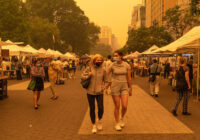The summer solstice (the longest day in the northern hemisphere) on June 21 heralded the beginning of yet another hot summer for the planet. Heat records were being shattered across the globe even before the summer of 2024 got going.
2023 was the hottest year on record, besting the previous record set in 2016. With the dissipation of El Niño, a phenomenon relating to warmer-than-average waters of the tropical Pacific Ocean, there is some hope that 2024 may not be a back-to-back record-setting year. Yet that remains to be seen, as May 2024, the hottest May on record, marked 12 consecutive months of record-breaking warmth.
Scientists and meteorologists face a challenge. They have invented ominous-sounding phrases like “polar vortex,” “bomb cyclone” and “atmospheric river” to showcase extreme weather phenomena driven by global warming and climate changes. In comparison, “heat wave” sounds so tepid, so lukewarm, to talk about a phenomenon that is killing humanity by the hordes.
Record deaths
The death toll from the record-setting heat of 2023 in the US was more than 2,300, the majority occurring in the state of Arizona. Arizona’s capital, Phoenix, sweltered in the heat for a continuous 19-day period, with practically no relief even during the nighttime, when temperatures stayed north of 32°C (90°F). The statistics were equally staggering in Europe, where France saw more than 5,000 lives lost to the heatwave. The death toll across the European continent is expected to surpass 55,000.
One would expect the numbers to be significantly higher in the Indian subcontinent, the world’s most populous region. However, the data presented to the Indian lower parliament, Lok Sabha, in July 2023 was 264, an unbelievably low number considering India’s harsh heatwave.
The summer of 2024 has already resulted in hundreds of heat-related deaths in India and Saudi Arabia, where the temperatures have been reaching scorching levels. Mecca, the seat of the Hajj pilgrimage, saw temperatures rise above 52°C (125°F), where more than 1300 people have died on account of heat. New Delhi saw temperatures soar above 50°C (122°F) in May, prompting authorities to issue a red alert. In India, the peak heat season is three months before the arrival of the southwest monsoon in June. During this period, the death toll in India has topped 100, while more than 40,000 people have fallen victim to heat stroke.
Heat, the human body and aging
Extreme heat affects human beings at many levels. At the low end is heat exhaustion, typically accompanied by headache, dizziness and sometimes fainting. A heat stroke is more severe and occurs when the body temperature goes above 39°C (103°F), resulting in cognitive dissonance, delirium and even loss of consciousness. The shift from exhaustion to stroke happens when a person stops sweating, a critical aspect in regulating the body temperature.
Extreme heat also affects the functioning of many organs in the human body. Breathing in hot air can cause lung-related complications, accentuating asthma and Chronic Obstructive Pulmonary Disease (COPD). If accompanied by dehydration, it can impair the functioning of the kidney, resulting in renal complications. The cardiovascular system shifts into high gear, trying to regulate the internal body temperature, causing increased stress on the heart.
The most vulnerable to heat exhaustion, heat stroke and heat-related organ failures resulting in death fall into two categories: the old and the poor.
Nearly 75%, or about 3,700 of the 5,000 deaths in France were people aged 75 or older. Climate Central estimates more than 12,000 people die in the United States from heat-related causes, far above the 2,300 number mentioned in the Associated Press analysis of Center for Disease Control and Prevention data. Climate Central estimates more than 80% of heat victims to be over 60.
As people age, they tend to develop chronic health conditions and their ability to tell how hot it is or how dehydrated they are also declines. Coupled with their cognitive dissonance and a less-than-optimal functioning cardiovascular system, it is no surprise that across the globe, the majority of heat victims tend to be older people.
Survival of the richest
The second demographic that bears disproportionate hardship from the heatwaves is the poor.
Delhi is experiencing the same conditions that Phoenix did last year when the nighttime temperatures stayed dangerously high for several days. When the brutal heat of the day persists through the night, the human body has no chance to refresh and reset for a new day.
National Public Radio (NPR) featured the tragic stories of several poor New Delhi residents living in windy conditions and being short on water while the temperatures soared to 49.5°C (121°F). Nothing can be more heartbreaking than the death of Ina Khan, a six-month-old baby who just died in her nap. The only shelter her low-income family could provide her was a blue plastic sheet over a dusty scrap of land. On that fateful day in late May, Ansar Khan pacified his crying daughter with some milk, and the family took a short nap while the unrelenting heat scorched the air around them.
Ina Khan would never wake up from her nap. “It was all over in half an hour,” Khan told NPR.
Near the same makeshift shelter where Ina died, Salma lost her two-day-old baby to Delhi’s punishing heat.
Salma never even got a chance to name her baby.
Taranum, who is marginally better off than Salma or Ansar Khan’s families, said in an interview with NPR, “I can’t die. We are homeless. Who will take care of my daughters?”
Taranum considers herself fortunate compared to Salma and Khan simply because she and her three daughters have an assigned bed in a homeless shelter for women and children.
Stories similar to Taranum, Khan or Salma are unlikely to come from someone well off and with access to running water and air-conditioned comfort.
Each year, we are vying to break the record-setting heat of a recent one, helped by climate change, resulting in more severe heat waves occurring more frequently. A 2020 study by McKinsey forebodes a dystopic future for India, with some parts of the country becoming unlivable without air conditioning.
In Hindi, the phrase “Roti, Kapda aur Makan” captures the bottommost section of Abraham Maslow’s hierarchy of needs — food, clothing and shelter. In the face of growing inequity between the rich and the poor and impending doom, where parts of the earth may become uninhabitable without air conditioning, one has to wonder if the phrase needs to be changed to “Roti, Kapda, Makan aur Hawa,” adding air to a human’s basic need.
The safety net society offers the poor falls far short of Maslow’s basic needs today. Sadly, if that does not improve regarding real shelter from heatwaves, survival of the fittest would essentially become survival of the richest.
[Liam Roman edited this piece.]
The views expressed in this article are the author’s own and do not necessarily reflect Fair Observer’s editorial policy.
Support Fair Observer
We rely on your support for our independence, diversity and quality.
For more than 10 years, Fair Observer has been free, fair and independent. No billionaire owns us, no advertisers control us. We are a reader-supported nonprofit. Unlike many other publications, we keep our content free for readers regardless of where they live or whether they can afford to pay. We have no paywalls and no ads.
In the post-truth era of fake news, echo chambers and filter bubbles, we publish a plurality of perspectives from around the world. Anyone can publish with us, but everyone goes through a rigorous editorial process. So, you get fact-checked, well-reasoned content instead of noise.
We publish 2,500+ voices from 90+ countries. We also conduct education and training programs
on subjects ranging from digital media and journalism to writing and critical thinking. This
doesn’t come cheap. Servers, editors, trainers and web developers cost
money.
Please consider supporting us on a regular basis as a recurring donor or a
sustaining member.
Will you support FO’s journalism?
We rely on your support for our independence, diversity and quality.







Comment